Bridge

Wiesen Viaduct in Switzerland
A bridge is a structure built to span physical obstacles without closing the way underneath such as a body of water, valley, or road, for the purpose of providing passage over the obstacle, usually something that can be detrimental to cross otherwise. There are many different designs that each serve a particular purpose and apply to different situations. Designs of bridges vary depending on the function of the bridge, the nature of the terrain where the bridge is constructed and anchored, the material used to make it, and the funds available to build it.
Most likely the earliest bridges were fallen trees and stepping stones, while Neolithic people built boardwalk bridges across marshland. The Arkadiko Bridge dating from the 13th century BC, in the Peloponnese, in southern Greece is one of the oldest arch bridges still in existence and use.
Contents
1 Etymology
2 History
2.1 Animals
3 Types of bridges
3.1 Structure type
3.2 Fixed or movable bridges
3.3 Double-decked bridges
3.4 Viaducts
3.5 Three-way bridges
3.6 Bridge types by use
3.7 Bridge types by material
4 Aesthetics
5 Bridge maintenance
6 Bridge failures
7 Bridge monitoring
8 Visual index
9 See also
10 References
11 Further reading
12 External links
Etymology

The Akashi Kaikyō Bridge in Japan, currently the world's longest suspension span

The Siosepol bridge over Zayandeh River is an example of Safavid dynasty (1502–1722) bridge design. Esfahan, Iran
The Oxford English Dictionary traces the origin of the word bridge to an Old English word brycg, of the same meaning.[1] The word can be traced directly back to Proto-Indo-European *bʰrēw-. The word for the card game of the same name has a different origin.
History
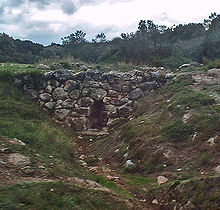
The Arkadiko Bridge in Greece (13th century BC), one of the oldest arch bridges in existence

Bridges in Amsterdam, Netherlands
The simplest type of a bridge is stepping stones, so this may have been one of the earliest types. Neolithic people also built a form of a boardwalk across marshes, of which the Sweet Track, and the Post Track are examples from England, that are around 6000 years old.[2] Undoubtedly ancient peoples would also have used log bridges; that is a timber bridge[3] that fall naturally or are intentionally felled or placed across streams. Some of the first man-made bridges with significant span were probably intentionally felled trees.[4]
Among the oldest timber bridges is the Holzbrücke Rapperswil-Hurden crossing upper Lake Zürich in Switzerland; the prehistoric timber piles discovered to the west of the Seedamm date back to 1523 BC. The first wooden footbridge led across Lake Zürich, followed by several reconstructions at least until the late 2nd century AD, when the Roman Empire built a 6-metre-wide (20 ft) wooden bridge. Between 1358 and 1360, Rudolf IV, Duke of Austria, built a 'new' wooden bridge across the lake that has been used to 1878 – measuring approximately 1,450 metres (4,760 ft) in length and 4 metres (13 ft) wide. On April 6, 2001, the reconstructed wooden footbridge was opened, being the longest wooden bridge in Switzerland.
The Arkadiko Bridge is one of four Mycenaean corbel arch bridges part of a former network of roads, designed to accommodate chariots, between the fort of Tiryns and town of Epidauros in the Peloponnese, in southern Greece. Dating to the Greek Bronze Age (13th century BC), it is one of the oldest arch bridges still in existence and use.
Several intact arched stone bridges from the Hellenistic era can be found in the Peloponnese.[5]
The greatest bridge builders of antiquity were the ancient Romans.[6] The Romans built arch bridges and aqueducts that could stand in conditions that would damage or destroy earlier designs. Some stand today.[7] An example is the Alcántara Bridge, built over the river Tagus, in Spain. The Romans also used cement, which reduced the variation of strength found in natural stone.[8] One type of cement, called pozzolana, consisted of water, lime, sand, and volcanic rock. Brick and mortar bridges were built after the Roman era, as the technology for cement was lost (then later rediscovered).
In India, the Arthashastra treatise by Kautilya mentions the construction of dams and bridges.[9] A Mauryan bridge near Girnar was surveyed by James Princep.[10] The bridge was swept away during a flood, and later repaired by Puspagupta, the chief architect of emperor Chandragupta I.[10] The use of stronger bridges using plaited bamboo and iron chain was visible in India by about the 4th century.[11] A number of bridges, both for military and commercial purposes, were constructed by the Mughal administration in India.[12]
Although large Chinese bridges of wooden construction existed at the time of the Warring States, the oldest surviving stone bridge in China is the Zhaozhou Bridge, built from 595 to 605 AD during the Sui Dynasty. This bridge is also historically significant as it is the world's oldest open-spandrel stone segmental arch bridge. European segmental arch bridges date back to at least the Alconétar Bridge (approximately 2nd century AD), while the enormous Roman era Trajan's Bridge (105 AD) featured open-spandrel segmental arches in wooden construction.[citation needed]
Rope bridges, a simple type of suspension bridge, were used by the Inca civilization in the Andes mountains of South America, just prior to European colonization in the 16th century.
During the 18th century there were many innovations in the design of timber bridges by Hans Ulrich Grubenmann, Johannes Grubenmann, and others. The first book on bridge engineering was written by Hubert Gautier in 1716.
A major breakthrough in bridge technology came with the erection of the Iron Bridge in Shropshire, England in 1779. It used cast iron for the first time as arches to cross the river Severn.[13]
With the Industrial Revolution in the 19th century, truss systems of wrought iron were developed for larger bridges, but iron does not have the tensile strength to support large loads. With the advent of steel, which has a high tensile strength, much larger bridges were built, many using the ideas of Gustave Eiffel.[citation needed]
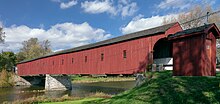
The covered bridge in West Montrose, Ontario, Canada
In Canada and the U.S., numerous timber Covered bridges were built in the late 1700s to the late 1800s, reminiscent of earlier designs in Germany and Switzerland. (Some covered bridges were also built in Asia.)[14] In later years, some were partly made of stone or metal but the trusses were usually still made of wood; in the US, there were three styles of trusses, the Queen Post, the Burr Arch and the Town Lattice.[15] Hundreds of these structures still stand in North America. They were brought to the attention of the general public in the 1990s by the novel, movie, and play The Bridges of Madison County.[16][17]
In 1927 welding pioneer Stefan Bryła designed the first welded road bridge in the world, the Maurzyce Bridge which was later built across the river Słudwia at Maurzyce near Łowicz, Poland in 1929. In 1995, the American Welding Society presented the Historic Welded Structure Award for the bridge to Poland.[18]
Animals

Eciton sp. forming a bridge
Before humans, ants have been making bridges using their own bodies to allow others to cross.
Types of bridges
Bridges can be categorized in several different ways. Common categories include the type of structural elements used, by what they carry, whether they are fixed or movable, and by the materials used.
Structure type
Bridges may be classified by how the forces of tension, compression, bending, torsion and shear are distributed through their structure. Most bridges will employ all of the principal forces to some degree, but only a few will predominate. The separation of forces may be quite clear. In a suspension or cable-stayed span, the elements in tension are distinct in shape and placement. In other cases the forces may be distributed among a large number of members, as in a truss.
 Beam bridge Beam bridge | Beam bridges are horizontal beams supported at each end by substructure units and can be either simply supported when the beams only connect across a single span, or continuous when the beams are connected across two or more spans. When there are multiple spans, the intermediate supports are known as piers. The earliest beam bridges were simple logs that sat across streams and similar simple structures. In modern times, beam bridges can range from small, wooden beams to large, steel boxes. The vertical force on the bridge becomes a shear and flexural load on the beam which is transferred down its length to the substructures on either side[19] They are typically made of steel, concrete or wood. Girder bridges and Plate girder bridges, usually made from steel, are types of Beam bridges. Box girder bridges, made from steel, concrete, or both are also beam bridges. Beam bridge spans rarely exceed 250 feet (76 m) long, as the flexural stresses increase proportional to the square of the length (and deflection increases proportional to the 4th power of the length).[20] However, the main span of the Rio-Niteroi Bridge, a box girder bridge, is 300 metres (980 ft).[citation needed] The world's longest beam bridge is Lake Pontchartrain Causeway in southern Louisiana in the United States, at 23.83 miles (38.35 km), with individual spans of 56 feet (17 m).[21] Beam bridges are the simplest and oldest type[22] of bridge in use today, and are a popular type.[23] |
 Truss bridge Truss bridge | A truss bridge is a bridge whose load-bearing superstructure is composed of a truss. This truss is a structure of connected elements forming triangular units. The connected elements (typically straight) may be stressed from tension, compression, or sometimes both in response to dynamic loads. Truss bridges are one of the oldest types of modern bridges. The basic types of truss bridges shown in this article have simple designs which could be easily analyzed by nineteenth and early twentieth century engineers. A truss bridge is economical to construct owing to its efficient use of materials. |
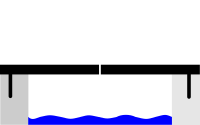 Cantilever bridge Cantilever bridge | Cantilever bridges are built using cantilevers—horizontal beams supported on only one end. Most cantilever bridges use a pair of continuous spans that extend from opposite sides of the supporting piers to meet at the center of the obstacle the bridge crosses. Cantilever bridges are constructed using much the same materials & techniques as beam bridges. The difference comes in the action of the forces through the bridge. Some cantilever bridges also have a smaller beam connecting the two cantilevers, for extra strength. The largest cantilever bridge is the 549-metre (1,801 ft) Quebec Bridge in Quebec, Canada. |
 Arch bridge Arch bridge | Arch bridges have abutments at each end. The weight of the bridge is thrust into the abutments at either side. The earliest known arch bridges were built by the Greeks, and include the Arkadiko Bridge. With the span of 220 metres (720 ft), the Solkan Bridge over the Soča River at Solkan in Slovenia is the second largest stone bridge in the world and the longest railroad stone bridge. It was completed in 1905. Its arch, which was constructed from over 5,000 tonnes (4,900 long tons; 5,500 short tons) of stone blocks in just 18 days, is the second largest stone arch in the world, surpassed only by the Friedensbrücke (Syratalviadukt) in Plauen, and the largest railroad stone arch. The arch of the Friedensbrücke, which was built in the same year, has the span of 90 m (295 ft) and crosses the valley of the Syrabach River. The difference between the two is that the Solkan Bridge was built from stone blocks, whereas the Friedensbrücke was built from a mixture of crushed stone and cement mortar.[24] The world's current largest arch bridge is the Chaotianmen Bridge over the Yangtze River with a length of 1,741 m (5,712 ft) and a span of 552 m (1,811 ft). The bridge was opened April 29, 2009 in Chongqing, China.[25] |
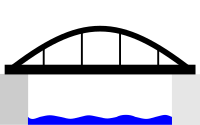 Tied arch bridge Tied arch bridge | Tied arch bridges have an arch-shaped superstructure, but differ from conventional arch bridges. Instead of transferring the weight of the bridge and traffic loads into thrust forces into the abutments, the ends of the arches are restrained by tension in the bottom chord of the structure. They are also called bowstring arches. |
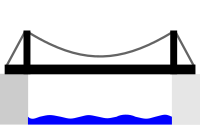 Suspension bridge Suspension bridge | Suspension bridges are suspended from cables. The earliest suspension bridges were made of ropes or vines covered with pieces of bamboo. In modern bridges, the cables hang from towers that are attached to caissons or cofferdams. The caissons or cofferdams are implanted deep into the bed of the lake, river or sea. Sub-types include the simple suspension bridge, the stressed ribbon bridge, the underspanned suspension bridge, the suspended-deck suspension bridge, and the self-anchored suspension bridge. There is also what is sometimes called a "semi-suspension" bridge, of which the Ferry Bridge in Burton-upon-Trent is the only one of its kind in Europe.[26] The longest suspension bridge in the world is the 3,909 m (12,825 ft) Akashi Kaikyō Bridge in Japan.[27] |
 Cable-stayed bridge Cable-stayed bridge | Cable-stayed bridges, like suspension bridges, are held up by cables. However, in a cable-stayed bridge, less cable is required and the towers holding the cables are proportionately higher.[28] The first known cable-stayed bridge was designed in 1784 by C.T. (or C.J.) Löscher.[29][30] The longest cable-stayed bridge since 2012 is the Russky Bridge in Vladivostok, Russia.[31] |

New Champlain Bridge over the St Lawrence river, Montreal, Quebec, Canada. Will accommodate cars, bicycles and a light passenger train. To be commissionned end of 2018. The old bridge will be then de-constructed
Fixed or movable bridges
 Play media
Play mediaMoving a Bloomingdale Trail bridge from Ashland to Western in Chicago.
Most bridges are fixed bridges, meaning they have no moving parts and stay in one place until they fail or are demolished. Temporary bridges, such as Bailey bridges, are designed to be assembled, and taken apart, transported to a different site, and re-used. They are important in military engineering, and are also used to carry traffic while an old bridge is being rebuilt. Movable bridges are designed to move out of the way of boats or other kinds of traffic, which would otherwise be too tall to fit. These are generally electrically powered.[citation needed]
Double-decked bridges
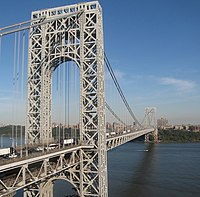
The double-decked George Washington Bridge, connecting New York City to Bergen County, New Jersey, US, is the world's busiest bridge, carrying 102 million vehicles annually.[32][33]
Double-decked (or double-decker) bridges have two levels, such as the George Washington Bridge, connecting New York City to Bergen County, New Jersey, US, as the world's busiest bridge, carrying 102 million vehicles annually;[32][33]truss work between the roadway levels provided stiffness to the roadways and reduced movement of the upper level when the lower level was installed three decades after the upper level. The Tsing Ma Bridge and Kap Shui Mun Bridge in Hong Kong have six lanes on their upper decks, and on their lower decks there are two lanes and a pair of tracks for MTR metro trains. Some double-decked bridges only use one level for street traffic; the Washington Avenue Bridge in Minneapolis reserves its lower level for automobile and light rail traffic and its upper level for pedestrian and bicycle traffic (predominantly students at the University of Minnesota). Likewise, in Toronto, the Prince Edward Viaduct has five lanes of motor traffic, bicycle lanes, and sidewalks on its upper deck; and a pair of tracks for the Bloor–Danforth subway line on its lower deck. The western span of the San Francisco–Oakland Bay Bridge also has two levels.
Robert Stephenson's High Level Bridge across the River Tyne in Newcastle upon Tyne, completed in 1849, is an early example of a double-decked bridge. The upper level carries a railway, and the lower level is used for road traffic. Other examples include Britannia Bridge over the Menai Strait and Craigavon Bridge in Derry, Northern Ireland. The Oresund Bridge between Copenhagen and Malmö consists of a four-lane highway on the upper level and a pair of railway tracks at the lower level. Tower Bridge in London is different example of a double-decked bridge, with the central section consisting of a low level bascule span and a high level footbridge.
Viaducts
A viaduct is made up of multiple bridges connected into one longer structure. The longest and some of the highest bridges are viaducts, such as the Lake Pontchartrain Causeway and Millau Viaduct.
Three-way bridges
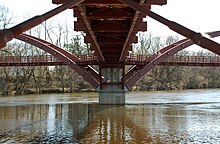
The three-way Tridge
A three-way bridge has three separate spans which meet near the center of the bridge. The bridge appears as a "T" or "Y" when viewed from above. Three-way bridges are extremely rare. The Tridge, Margaret Bridge, and Zanesville Y-Bridge are examples.
Bridge types by use
A bridge can be categorized by what it is designed to carry, such as trains, pedestrian or road traffic (road bridge), a pipeline or waterway for water transport or barge traffic. An aqueduct is a bridge that carries water, resembling a viaduct, which is a bridge that connects points of equal height. A road-rail bridge carries both road and rail traffic. Overway is a term for a bridge that separates incompatible intersecting traffic, especially road and rail.[34] A bridge can carry overhead power lines as does the Storstrøm Bridge.[citation needed]
Some bridges accommodate other purposes, such as the tower of Nový Most Bridge in Bratislava, which features a restaurant, or a bridge-restaurant which is a bridge built to serve as a restaurant. Other suspension bridge towers carry transmission antennas.[citation needed]
Bridges are subject to unplanned uses as well. The areas underneath some bridges have become makeshift shelters and homes to homeless people, and the undertimbers of bridges all around the world are spots of prevalent graffiti. Some bridges attract people attempting suicide, and become known as suicide bridges.[citation needed]
Bridge types by material

The Iron Bridge completed in 1781 was the first cast iron bridge.
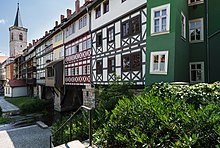
Krämerbrücke in Erfurt, Germany – with half timbered buildings

Small stone bridge, Othonoi, Greece
The materials used to build the structure are also used to categorize bridges. Until the end of the 18th Century, bridges were made out of timber, stone and masonry. Modern bridges are currently built in concrete, steel, fiber reinforced polymers (FRP), stainless steel or combinations of those materials. Living bridges have been constructed of live plants such as Ficus elastica tree roots in India[35] and wisteria vines in Japan.[36][citation needed]
| Bridge type | Materials used |
|---|---|
| Cantilever | For small footbridges, the cantilevers may be simple beams; however, large cantilever bridges designed to handle road or rail traffic use trusses built from structural steel, or box girders built from prestressed concrete.[37] |
| Suspension | The cables are usually made of steel cables galvanised with zinc,[citation needed] along with most of the bridge, but some bridges are still made with steel reinforced concrete.[38] |
| Arch | Stone, brick and other such materials that are strong in compression and somewhat so in shear. |
| Beam | Beam bridges can use pre-stressed concrete, an inexpensive building material, which is then embedded with rebar. The resulting bridge can resist both compression and tension forces.[39] |
| Truss | The triangular pieces of Truss bridges are manufactured from straight and steel bars, according to the truss bridge designs.[40] |
Aesthetics
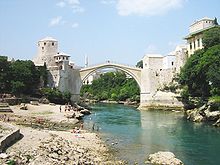
The World Heritage Site of Stari Most (Old Bridge) gives its name to the city of Mostar, Bosnia and Herzegovina
Most bridges are utilitarian in appearance, but in some cases, the appearance of the bridge can have great importance. Often, this is the case with a large bridge that serves as an entrance to a city, or crosses over a main harbor entrance. These are sometimes known as signature bridges. Designers of bridges in parks and along parkways often place more importance to aesthetics, as well. Examples include the stone-faced bridges along the Taconic State Parkway in New York.
To create a beautiful image, some bridges are built much taller than necessary. This type, often found in east-Asian style gardens, is called a Moon bridge, evoking a rising full moon. Other garden bridges may cross only a dry bed of stream washed pebbles, intended only to convey an impression of a stream. Often in palaces a bridge will be built over an artificial waterway as symbolic of a passage to an important place or state of mind. A set of five bridges cross a sinuous waterway in an important courtyard of the Forbidden City in Beijing, China. The central bridge was reserved exclusively for the use of the Emperor, Empress, and their attendants.
Bridge maintenance

Highway bridge treated with high-frequency impact treatment
Bridge maintenance consisting of a combination of structural health monitoring and testing. This is regulated in country-specific engineer standards and includes e.g. an ongoing monitoring every three to six months, a simple test or inspection every two to three years and a major inspection every six to ten years. In Europe, the cost of maintenance is higher than spending on new bridges. The lifetime of welded steel bridges can be significantly extended by aftertreatment of the weld transitions . This results in a potential high benefit, using existing bridges far beyond the planned lifetime.
Bridge failures
The failure of bridges is of special concern for structural engineers in trying to learn lessons vital to bridge design, construction and maintenance. The failure of bridges first assumed national interest during the Victorian era when many new designs were being built, often using new materials.
In the United States, the National Bridge Inventory tracks the structural evaluations of all bridges, including designations such as "structurally deficient" and "functionally obsolete".
Bridge monitoring
There are several methods used to monitor the stress on large structures like bridges. The most common method is the use of an accelerometer, which is integrated into the bridge while it is being built. This technology is used for long-term surveillance of the bridge.[41]
Another option for structural-integrity monitoring is "non-contact monitoring", which uses the Doppler effect (Doppler shift). A laser beam from a Laser Doppler Vibrometer is directed at the point of interest, and the vibration amplitude and frequency are extracted from the Doppler shift of the laser beam frequency due to the motion of the surface.[42] The advantage of this method is that the setup time for the equipment is faster and, unlike an accelerometer, this makes measurements possible on multiple structures in as short a time as possible. Additionally, this method can measure specific points on a bridge that might be difficult to access.
Snapshots in time of the external condition of a bridge can be recorded using Lidar to aid bridge inspection.[43]
Visual index
See also
- Architectural engineering
- Bridge chapel
- Bridge tower
- Bridge to nowhere
- Bridges Act
- BS 5400
- BT Centre for Major Programme Management
- Causeway
- Coal trestle
- Covered bridges
- Cross-sea traffic ways
- Culvert
- Deck
- Devil's Bridge
- Footbridge
- Landscape architecture
- Megaproject
- Military bridges
- Overpass
- Pontoon bridge
- Rigid-frame bridge
- Transporter bridge
- Tensegrity
- Trestle bridge
- Tunnel
References
^ Fowler (1925). The Concise Oxford Dictionary. Oxford University Press. p. 102..mw-parser-output cite.citationfont-style:inherit.mw-parser-output qquotes:"""""""'""'".mw-parser-output code.cs1-codecolor:inherit;background:inherit;border:inherit;padding:inherit.mw-parser-output .cs1-lock-free abackground:url("//upload.wikimedia.org/wikipedia/commons/thumb/6/65/Lock-green.svg/9px-Lock-green.svg.png")no-repeat;background-position:right .1em center.mw-parser-output .cs1-lock-limited a,.mw-parser-output .cs1-lock-registration abackground:url("//upload.wikimedia.org/wikipedia/commons/thumb/d/d6/Lock-gray-alt-2.svg/9px-Lock-gray-alt-2.svg.png")no-repeat;background-position:right .1em center.mw-parser-output .cs1-lock-subscription abackground:url("//upload.wikimedia.org/wikipedia/commons/thumb/a/aa/Lock-red-alt-2.svg/9px-Lock-red-alt-2.svg.png")no-repeat;background-position:right .1em center.mw-parser-output .cs1-subscription,.mw-parser-output .cs1-registrationcolor:#555.mw-parser-output .cs1-subscription span,.mw-parser-output .cs1-registration spanborder-bottom:1px dotted;cursor:help.mw-parser-output .cs1-hidden-errordisplay:none;font-size:100%.mw-parser-output .cs1-visible-errorfont-size:100%.mw-parser-output .cs1-subscription,.mw-parser-output .cs1-registration,.mw-parser-output .cs1-formatfont-size:95%.mw-parser-output .cs1-kern-left,.mw-parser-output .cs1-kern-wl-leftpadding-left:0.2em.mw-parser-output .cs1-kern-right,.mw-parser-output .cs1-kern-wl-rightpadding-right:0.2em
^ Brunning, Richard (February 2001). "The Somerset Levels". Current Archaeology. XV (4) (172 (Special issue on Wetlands)): 139–143.
^ National Parks Conference, Department of the Interior (1915). Proceedings of the National parks conference held at Berkeley, California March 11, 12, and 13, 1915. Washington, DC: Government Printing Office. p. 60. Retrieved March 14, 2010.(A log bridge) is a bridge composed of log beams, the logs being in natural condition or hewn, which are thrown across two abutments, and over which traffic may pass.
^ Bennett, David (2000). "The history and development of bridges". In Ryall, M.J.; Parke, G.A.R.; Harding, J.E. The manual of bridge engineering (Google books). London: Thomas Telford. p. 1. ISBN 978-0727727749. Retrieved March 14, 2010.
^ Kutz, Myer (2011). Handbook of Transportation Engineering, Volume II: Applications and Technologies, Second Edition. McGraw-Hill Professional. ISBN 978-0071614771.
^ DeLony, Eric (1996). "Context for World Heritage Bridges". Icomos.org. Archived from the original on February 21, 2005.
^ "History of Bridges". Historyworld.net. Archived from the original on January 6, 2012. Retrieved January 4, 2012.
^ "Lessons from Roman Cement and Concrete". Pubs.asce.org. Archived from the original on February 10, 2005. Retrieved January 4, 2012.
^ Dikshitar, V.R.R. Dikshitar (1993). The Mauryan Polity, Motilal Banarsidass, p. 332
ISBN 8120810236.
^ ab Dutt, Romesh Chunder (2000). A History of Civilisation in Ancient India: Vol II, Routledge, p. 46,
ISBN 0415231884.
^ "suspension bridge" in Encyclopædia Britannica (2008). 2008 Encyclopædia Britannica, Inc.
^ Nath, R. (1982). History of Mughal Architecture, Abhinav Publications, p. 213,
ISBN 8170171598.
^ "Iron Bridge". Engineering Timelines. Engineering Timelines. Archived from the original on March 4, 2016. Retrieved November 18, 2016.
^ "Historic Wooden Bridges/"Covered Bridges"". HSNB.DE. July 11, 2011. Retrieved October 15, 2018.
^ "Hidden Masterpieces: Covered Bridges in PA". Pennsylvania Book Center. Spring 2010. Retrieved October 15, 2018.
^ "Throwback Thursday: Covered bridges". Canadian Geographic. May 28, 2015. Retrieved October 15, 2018.
^ "Visit America's Most Idyllic Covered Bridges". Architectural Digest. December 2016. Retrieved October 15, 2018.
^ Sapp, Mark E. (February 22, 2008). "Welding Timeline 1900–1950". WeldingHistory.org. Archived from the original on August 3, 2008. Retrieved April 29, 2008.
^ "Beam bridges". Design Technology. Archived from the original on May 18, 2008. Retrieved May 14, 2008.
^ Structural Beam Deflection Stress Bending Equations / Calculation Supported on Both Ends Uniform Loading Archived January 22, 2013, at Archive.is. Engineers Edge. Retrieved on April 23, 2013.
^ "A big prefabricated bridge". Life. 40 (22): 53–60. May 28, 1956.
^ "ASCE | Civil What? | Bridges". www.asceville.org. Archived from the original on February 3, 2017. Retrieved February 2, 2017.
^ Naito, Clay; Sause, Richard; Hodgson, Ian; Pessiki, Stephen; Macioce, Thomas (2010). "Forensic Examination of a Noncomposite Adjacent Precast Prestressed Concrete Box Beam Bridge". Journal of Bridge Engineering. 15 (4): 408–418. doi:10.1061/(ASCE)BE.1943-5592.0000110.
^ Gorazd Humar (September 2001). "World Famous Arch Bridges in Slovenia". In Charles Abdunur. Arch'01: troisième Conférence internationale sur les ponts en arc Paris: (in English and French). Paris: Presses des Ponts. pp. 121–124. ISBN 2859783474. Archived from the original on July 30, 2016.
^ "Longest bridge, steel arch bridge". Guinness World Records. Archived from the original on October 19, 2013. Retrieved February 18, 2013.
^ A.O.P. Guide to Burton-on-Trent, 1911, p. 13
^ Sigmund, Pete (February 7, 2007). "The Mighty Mac: A Sublime Engineering Feat". Construction Equipment Guide. Archived from the original on April 5, 2013. Retrieved May 14, 2008.
^ Johnson, Andy. "Cable Stay vs Suspension Bridges". U.S. Department of Energy. Archived from the original on May 18, 2008.
^ Walther, René (1999). Cable Stayed Bridges. p. 7. ISBN 978-0727727732. Archived from the original on November 15, 2016.
^ Poser, Marcel. "Cable Stayed Structures and Stay Cable Technology" (PDF). Archived from the original (PDF) on February 9, 2013.
^ Elder, Miriam (July 2, 2012). "Russian city of Vladivostok unveils record-breaking suspension bridge". The Guardian. London. Archived from the original on January 20, 2016. Retrieved February 3, 2016.
^ ab "Port Authority of New York and New Jersey – George Washington Bridge". The Port Authority of New York and New Jersey. Archived from the original on September 20, 2013. Retrieved September 13, 2013.
^ ab Bod Woodruff; Lana Zak & Stephanie Wash (November 20, 2012). "GW Bridge Painters: Dangerous Job on Top of the World's Busiest Bridge". ABC News. Archived from the original on September 28, 2013. Retrieved September 13, 2013.
^ "The Mile-End Crossing". The Observer. LXXXI, (6, 004). South Australia. February 23, 1924. p. 16. Retrieved March 26, 2018 – via National Library of Australia.
^ "How are Living Root Bridges Made?". The Living Root Bridge Project. May 5, 2017. Archived from the original on September 5, 2017. Retrieved September 8, 2017.
^ "The Vine Bridges of Iya Valley". Atlas Obscura. Archived from the original on September 8, 2017. Retrieved September 8, 2017.
^ "Cantilever". Bridges of Dublin. Archived from the original on October 29, 2014.
^ "Suspension Bridges". Made How. Archived from the original on January 2, 2015.
^ "Beam Bridges". PBS. Archived from the original on January 6, 2015.
^ K, Aggeliki; Stonecypher, Lamar (2010-02-10). "Truss Bridge Designs". Bright Hub Engineering. Archived from the original on February 19, 2015.
^ "The new Minnesota smart bridge" (PDF). mnme.com. Archived (PDF) from the original on August 23, 2012. Retrieved January 30, 2012.
^ "Basic Principles of Vibrometry". polytec.com. Archived from the original on June 10, 2012. Retrieved January 25, 2012.
^ Omer; et al. (2018). "Performance evaluation of bridges using virtual reality". Proceedings of the 6th European Conference on Computational Mechanics (ECCM 6) & 7th European Conference on Computational Fluid Dynamics (ECFD 7), Glasgow, Scotland.
Further reading
- Brown, David J. Bridges: Three Thousand Years of Defying Nature. Richmond Hill, Ont: Firefly Books, 2005.
ISBN 1554070996. - Sandak, Cass R. Bridges. An Easy-read modern wonders book. New York: F. Watts, 1983.
ISBN 0531046249. - Whitney, Charles S. Bridges of the World: Their Design and Construction. Mineola, NY: Dover Publications, 2003.
ISBN 0486429954 (Unabridged republication of Bridges : a study in their art, science, and evolution. 1929.)
External links
Digital Bridge: Bridges of the Nineteenth Century, a collection of digitized books at Lehigh University
Structurae – International Database and Gallery of Engineerings Structures with over 10000 Bridges.- U.S. Federal Highway Administration Bridge Technology
The Museum of Japanese Timber Bridges Fukuoka University- "bridge-info.org": site for bridges

